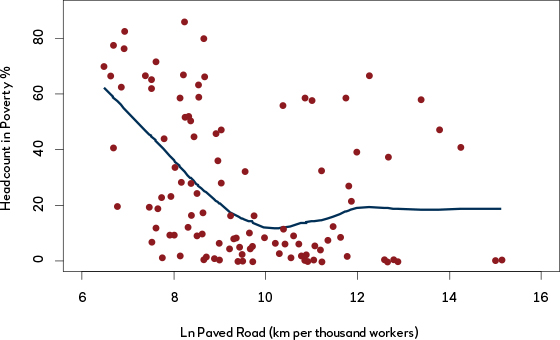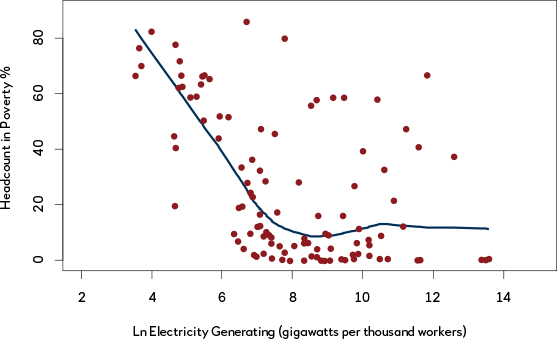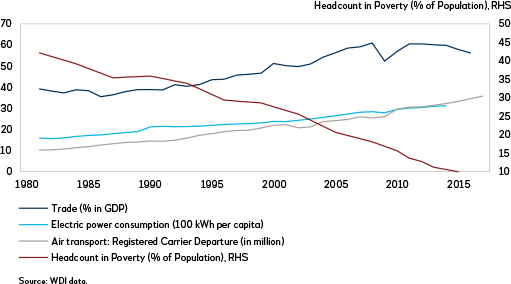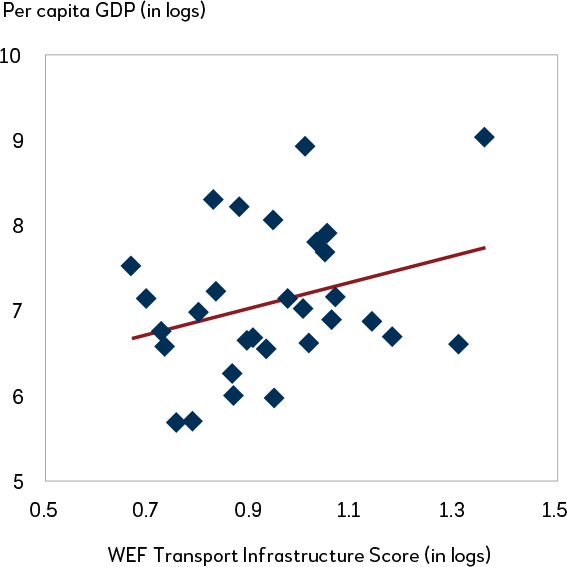There is a well-known saying “To get rich, build a road; 要想富,先修路.” At the heart of this folk saying is the idea that bridging borders and increasing connectivity through infrastructure is a prerequisite to growth and prosperity. However, understanding the facts behind the saying—the links between connectivity and income growth and poverty reduction—is important for investment decisions on connectivity infrastructure.
Role of domestic connectivity infrastructure
The positive role of domestic transport for economic growth has been confirmed by a large number of empirical studies. Connectivity directly lowers transport costs and increases market access and opportunities. Transport infrastructure improves social outcomes by improving physical access to social services such as schools and health clinics. There are also considerable non-pecuniary benefits, such as reduced traveling stress.
The most complete recent empirical studies are Donaldson (2018) and Donaldson and Hornbeck (2016). The first paper investigated the economic benefits of transport infrastructure development by measuring the effect of access to railroads on agriculture incomes and identifying the benefits of increased trade. The second paper used a “market access” approach to assess the benefits of railroad expansion in the US in the 19th century, finding that the US GNP would have decreased considerably without railroads.
Looking at a broader, cross-country dataset from the years of 1980, 1990 and 2000, there is a positive relationship between paved road and reduction of poverty, especially when the paved road is low (see Figure 11). Likewise, and related, there is also a positive relationship between electrification and the reduction of poverty (see Figure 12).
Recent work using night-time light images captured from satellites also show how connectivity infrastructure results in the spread of economic activities.
Figure 11: Relationship between poverty and paved road

Source: A LOWESS smoother is used for the fitted line. The share of the population who are under the poverty line of USD1.91 per day from WDI dataset and the Infrastructure dataset from Calderón, Moral-Benito, Servén (2014).
Figure 12: Relationship between poverty and electricity generation capacity

Role of international connectivity and trade
The global poverty headcount ratio has declined from 42 percent in 1981, to 29 percent in 1999, and further to 10 percent in 2015, coinciding with a period of rising cross-border connectivity proxied by trade in goods and services and air transport (see Figure 13). But is international connectivity and trade the cause? Given the recent debates on globalization and trade, this is not just an academic question, but a policy one: are there good policy reasons to support greater international connectivity infrastructure and trade? Here, the results of various studies and discussions are understandably more nuanced.
It is suspected that trade and connectivity is the byproduct of what is termed as “economic geography” effects. Countries that find themselves closer to large markets will see more trade and higher incomes. There is similar evidence that countries’ per capita income differences can be explained by their relative proximities to large markets. However, infrastructure for international connectivity is probably a corollary, as opposed to the driver for growth.
This can be explored further by looking at the correlation between per capita income, and economic access and transport infrastructure, in a group of 30 of the world’s most remote countries. These tend to be in three regions: Central Asia, Sub-Saharan Africa and Latin America. Unsurprisingly, this is a group of small economies, with relatively low incomes so any increase in per capita GDP will have a strong impact on lifting populations from poverty.
As seen in the contrast between Figure 15 and Figure 16, geography arguably plays a less important role in explaining income differences as opposed to transport infrastructure. Geography is of course important, but it is not necessarily destiny. Economic geography, in particular, can be shaped and reshaped by infrastructure developments. For small economies with lower levels of domestic demand, greater domestic connectivity without investing in cross-border infrastructure will hardly improve market access.
Figure 13: Poverty incidence, trade and infrastructure (1980-2016)

Figure 14: Cross-country relationship between economic access and per capita GDP

Figure 15: Correlation between per capita income and economic access

Figure 16: Correlation between per capita income and transport infrastructure

Trade and poverty reduction
Beyond the effects on per capita income, in recent years there has been a greater focus on understanding the distributional impact of connectivity and trade, reflecting a growing unease with globalization. In India, recent work also points to the fact that greater trade may actually hurt the poor. Rural districts that experienced greater trade saw a higher incidence of poverty; the poor affected by trade could not move into new sectors or to areas with opportunities. In Latin America, there is also evidence that reliance on imports slowed the wage growth of manufacturing sectors.
In general, a host of strong empirical evidence suggests that rising incomes benefit the poor. When average incomes rise, the average incomes of the poorest fifth of society rise proportionately, and this holds across regions, periods, income levels and growth rates. Besides direct impact on incomes, recent research also shows that cross-border connectivity can also reduce the cost of imported goods, and these tend to benefit the poor disproportionately (as the rich consume more non-traded services). The weight of evidence now suggests that in order to provide uplift to the poor, having greater international connectivity and trade is not sufficient, but it has to be accompanied by improvements in the domestic policy settings.
The direction of causality from trade to income growth and poverty reduction may not be straightforward and necessarily depend on countries’ specific contexts. Yet, it is clear that raising drawbridges, internally or with the rest of the world, serves no purpose—domestic and international connectivity are both needed to fulfill the promise of infrastructure to raise income and reduce poverty.
